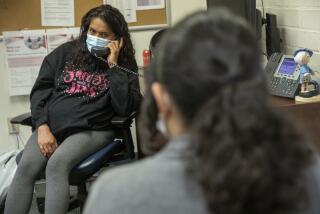Car Trouble on the Freeway? Stay Out of the Median
- Share via
Dear Street Smart:
I was wondering why there are no call boxes in the median of the freeways. I see an awful lot of people stuck there.
Rita Williams
Rancho Santa Margarita
Aside from certain spots in East Beirut, the median strip on a Southern California freeway is the most dangerous spot to be with a broken-down car. On most Orange County freeways, there’s hardly room for a bicycle to park, let alone an automobile.
With that in mind, the California Department of Transportation has avoided putting call boxes along the median strip, where they would be magnets for motorists in trouble, said Albert Miranda, a Caltrans spokesman.
Miranda said officials encourage motorists with flat tires, engine problems or other malfunctions to pull off to the nearest freeway exit or over to the shoulder, where they generally have a better chance of staying out of harm’s way.
That’s not always possible, of course. If the freeway is jam-packed when your Buick starts belching black smoke, you may have no choice but to stop in the median.
The first thing to do is avoid heart failure. Tell life to go pass in front of someone else’s eyes, then take steps to save your own hide. Miranda recommends taking a tip from Caltrans road crews: Get to the front of the car so you can use the vehicle as a shield from oncoming traffic; keep your eyes fixed on the cars barreling toward you.
Those tactics are also recommended for folks forced to stop on a freeway shoulder. Most of our local freeways, unlike members of the Los Angeles Rams, don’t have broad shoulders. In fact, some aren’t much wider than a median strip. The pressure to handle heavy traffic flow has resulted in crowding more lanes onto a freeway right-of-way that rarely gets bigger.
Dear Street Smart:
In the Feb. 5 edition, you had a letter from a woman who had a battered license plate that she wanted to have replaced but who had been told by the Department of Motor Vehicles that new plates for existing numbers are not issued. All she could do, they said, was get a new license number.
But she has another option--getting the plate restored. She could try Darryl’s Plates, 4505 8th Ave. South, No. A-10, St. Petersburg, Fla., 33711. He does a masterful job of restoring a plate for less than $25, including return shipping.
I just had one of those old black and gold California plates done by him, and it came back better than new.
As for the state requirement that plates be on both front and rear bumpers: A front license plate is ugly on a nice car. It’s a waste of taxpayers’ money besides.
Police will stop you if you have no front plate. I know. (I think they actually want to see one’s car close up if it is at all antique, modified or otherwise out of the ordinary.)
Jerry Bernheimer
Newport Beach
An interesting tip. There’s a whole cottage industry of folks who specialize in license plate repair and resale. Some people have made a business of salvaging the old black California plates from junkyards, then restoring and reselling them.
Using such restored plates is legal, according to Gina McGuiness, a spokeswoman for the state Department of Motor Vehicles in Sacramento. The job must be done properly, though. The plate cannot be cut down in size, and the original colors must be used.
Dear Street Smart:
I’m a police officer with the UC Irvine police department. In your article about minors in pickup truck beds (Feb. 19), you said that people under age 18 could not ride in a pickup bed.
I thought you might like to know that actually that’s not quite correct. The California Vehicle Code states that no one shall transport a minor under the age of 12 in the back of a truck unless it is enclosed to a height of 46 inches. The code also says that if the children are secured so as to prevent their being thrown, that makes it OK.
Scott Roberts
Irvine
Thanks for straightening that out. Street Smart’s answers are only as good as the information we get from officials with the California Highway Patrol, local police departments, Caltrans and other agencies. In this case, a lieutenant at the Highway Patrol’s Santa Ana office supplied incorrect information about the age limit for riders in pickup beds. Perhaps he’ll start doing a better job of reading his vehicle code handbook. And so will we.
More to Read
Sign up for Essential California
The most important California stories and recommendations in your inbox every morning.
You may occasionally receive promotional content from the Los Angeles Times.













